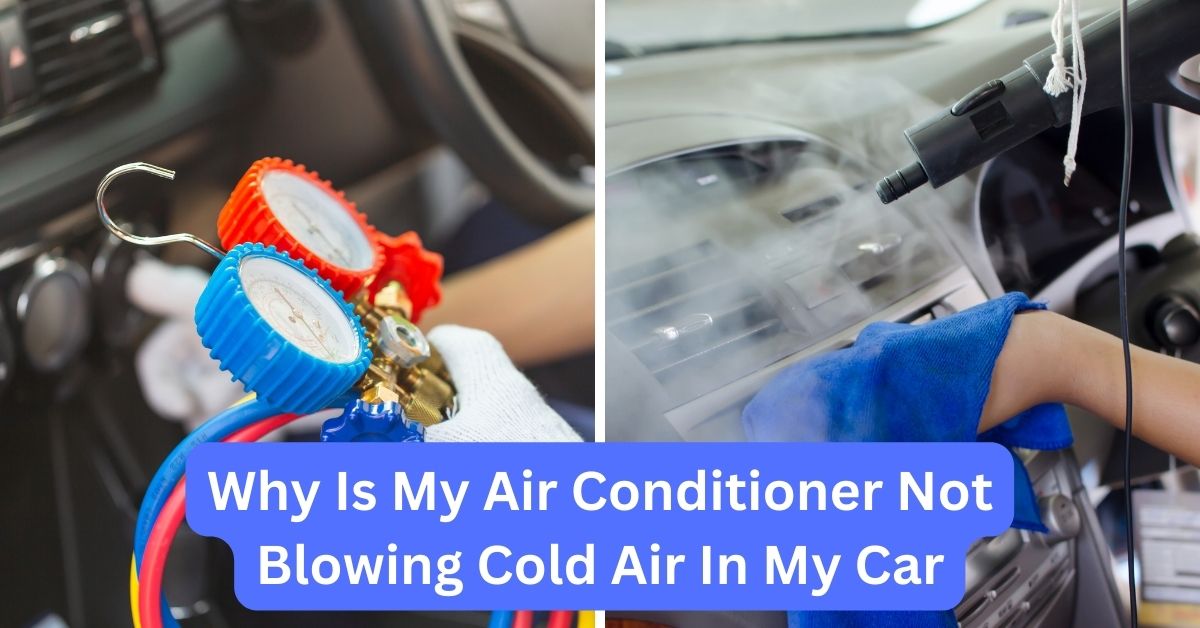My Air In My Car Is Blowing But Not Cold

My Car AC is Blowing Air, But It's Not Cold: Troubleshooting and Solutions
Few things are more frustrating than a car air conditioner that blows air, but fails to deliver that refreshing coolness on a sweltering day. Before you resign yourself to sweaty commutes, explore some common culprits and potential fixes. This comprehensive guide will walk you through the troubleshooting process, from simple DIY checks to when it's time to consult a professional.
Understanding the Basics of Car AC Systems
A car's AC system is a closed-loop system that relies on refrigerant to cool the air. The core components include:
- Compressor: Pumps the refrigerant through the system, increasing its pressure and temperature.
- Condenser: Dissipates heat from the high-pressure refrigerant, turning it into a liquid.
- Evaporator: Absorbs heat from the cabin air, causing the refrigerant to evaporate and cool the air.
- Expansion Valve (or Orifice Tube): Controls the flow of refrigerant into the evaporator, reducing its pressure and temperature.
- Refrigerant: The lifeblood of the system, absorbing and releasing heat as it circulates.
A problem in any of these components can lead to a malfunctioning AC system.
Common Causes and Troubleshooting Steps
1. Low Refrigerant Levels
The most frequent cause of weak or no cold air is low refrigerant. Over time, refrigerant can leak from the system due to loose fittings, damaged hoses, or a failing component. A small leak can slowly deplete the refrigerant charge, leading to a gradual decline in cooling performance.
Troubleshooting:
- Visual Inspection: Look for visible signs of leaks, such as oily residue around fittings, hoses, and the compressor.
- Refrigerant Gauge: Use an AC manifold gauge set to check the refrigerant pressure on both the low and high sides of the system. Compare the readings to the manufacturer's specifications for your vehicle. Low pressure readings indicate a leak or insufficient refrigerant.
- Refrigerant Dye: A UV dye can be added to the system to help locate leaks. After running the AC, use a UV light to scan for the dye, which will glow at the leak location.
Solution: If you suspect a leak, it's best to have a qualified technician identify and repair it. Simply adding refrigerant to a leaking system is a temporary fix and can damage the environment. Once the leak is repaired, the system can be properly recharged.
2. Faulty Compressor
The compressor is the heart of the AC system. If it fails, refrigerant cannot be circulated effectively, resulting in no cooling. Compressors can fail due to internal wear, electrical issues, or lack of lubrication.
Troubleshooting:
- Listen for Compressor Engagement: Turn on the AC and listen for a click sound as the compressor engages. If you don't hear the click, the compressor might not be receiving power or could be seized.
- Voltage Test: Use a multimeter to check if the compressor is receiving voltage when the AC is turned on.
- Mechanical Test: A mechanic can perform more advanced tests to assess the compressor's internal functionality, such as checking its pumping capacity.
Solution: A faulty compressor usually needs to be replaced. This is a more complex repair that requires specialized tools and knowledge. Consult a professional mechanic for this repair.
3. Blocked Condenser
The condenser's job is to dissipate heat from the refrigerant. If it's blocked by debris like leaves, bugs, or dirt, it cannot efficiently cool the refrigerant, resulting in poor AC performance.
Troubleshooting:
- Visual Inspection: Check the condenser (typically located in front of the radiator) for any obstructions.
- Water Spray Test: With the engine running and the AC on, spray the condenser with water. If the AC starts to blow colder air, it indicates that the condenser was likely blocked and not dissipating heat properly.
Solution: Remove any debris from the condenser. A gentle rinse with a garden hose can help dislodge dirt and bugs. Be careful not to damage the delicate fins.
4. Clogged Evaporator
A clogged evaporator restricts airflow and reduces its ability to absorb heat from the cabin air. This can be caused by dust, pollen, and other debris accumulating on the evaporator core.
Troubleshooting:
- Airflow Test: Check the airflow from the AC vents. Reduced airflow can indicate a clogged evaporator.
- Smell Test: A musty or moldy odor from the vents can also suggest a clogged evaporator, as moisture and debris can create a breeding ground for bacteria.
Solution: Cleaning the evaporator usually requires removing it from the vehicle, which can be a labor-intensive process. Some shops offer evaporator cleaning services without removal, using specialized cleaning solutions and tools.
5. Faulty Expansion Valve or Orifice Tube
The expansion valve (or orifice tube in some vehicles) regulates the flow of refrigerant into the evaporator. If it's clogged or malfunctioning, it can restrict refrigerant flow, leading to poor cooling.
Troubleshooting:
- Pressure Readings: Using an AC manifold gauge set, a technician can assess the pressure readings to determine if the expansion valve or orifice tube is functioning correctly. Unusual pressure differentials can indicate a problem.
Solution: A faulty expansion valve or orifice tube typically needs to be replaced. This repair often requires evacuating and recharging the AC system.
6. Electrical Issues
Electrical problems, such as blown fuses, faulty relays, or wiring issues, can prevent the AC system from functioning properly. These issues can affect the compressor, blower motor, or other components.
Troubleshooting:
- Fuse Check: Check the fuses related to the AC system for any blown fuses. Replace any blown fuses with the correct amperage rating.
- Relay Test: Use a multimeter to test the AC relay for proper operation.
- Wiring Inspection: Inspect the wiring harness for any signs of damage, such as frayed wires or loose connections.
Solution: Repair or replace any faulty electrical components. If you're not comfortable working with electrical systems, it's best to consult a qualified electrician or mechanic.
7. Blower Motor Problems
The blower motor circulates air through the evaporator and out of the vents. If the blower motor is not working, you might feel some cool air at the source, but it won't be effectively distributed into the cabin. Check if you have weak air blowing through the vents, or any at all.
Troubleshooting:
- Turn on the Blower Motor: Ensure that the blower motor isn't set to off or malfunctioning.
- Listen for Blower Motor Noise: Unusual noises from the blower motor, like squealing or grinding, can indicate a problem.
Solution: Replace the blower motor if faulty. Check the blower motor resistor as well.
Preventative Maintenance Tips for a Healthy Car AC System
Regular maintenance can help prevent AC problems and extend the life of your system:
- Run the AC Regularly: Even during the winter months, run the AC for a few minutes each week to keep the compressor lubricated and prevent seals from drying out.
- Check the Refrigerant Level: Have the refrigerant level checked periodically by a qualified technician.
- Clean the Condenser: Keep the condenser free of debris.
- Replace the Cabin Air Filter: A dirty cabin air filter can restrict airflow and reduce AC performance. Replace it regularly, as recommended by the manufacturer.
When to Call a Professional
While some AC problems can be addressed with DIY solutions, others require the expertise of a qualified technician. It's best to consult a professional if:
- You suspect a refrigerant leak.
- The compressor is not engaging.
- You are not comfortable working with electrical systems or refrigerant.
- You are unsure about the cause of the problem.
Cost Considerations
The cost of AC repairs can vary depending on the problem and the vehicle. Here's a general idea of what to expect:
- Refrigerant Recharge: $100-$300 (includes leak detection and repair if necessary)
- Compressor Replacement: $500-$1,200
- Condenser Replacement: $300-$700
- Evaporator Replacement: $800-$1,500
- Expansion Valve/Orifice Tube Replacement: $200-$500
These are just estimates, and the actual cost may vary.
Conclusion
A car AC system that's not blowing cold air can be a significant inconvenience. By following these troubleshooting steps, you can often identify the problem and determine the best course of action. Remember, preventative maintenance and timely repairs are key to keeping your AC system running smoothly and ensuring a comfortable driving experience.










